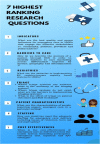Harnessing inter-disciplinary collaboration to improve emergency care in low- and middle-income countries (LMICs): results of research prioritisation setting exercise
- PMID: 32867675
- PMCID: PMC7457362
- DOI: 10.1186/s12873-020-00362-7
Harnessing inter-disciplinary collaboration to improve emergency care in low- and middle-income countries (LMICs): results of research prioritisation setting exercise
Abstract
Background: More than half of deaths in low- and middle-income countries (LMICs) result from conditions that could be treated with emergency care - an integral component of universal health coverage (UHC) - through timely access to lifesaving interventions.
Methods: The World Health Organization (WHO) aims to extend UHC to a further 1 billion people by 2023, yet evidence supporting improved emergency care coverage is lacking. In this article, we explore four phases of a research prioritisation setting (RPS) exercise conducted by researchers and stakeholders from South Africa, Egypt, Nepal, Jamaica, Tanzania, Trinidad and Tobago, Tunisia, Colombia, Ethiopia, Iran, Jordan, Malaysia, South Korea and Phillipines, USA and UK as a key step in gathering evidence required by policy makers and practitioners for the strengthening of emergency care systems in limited-resource settings.
Results: The RPS proposed seven priority research questions addressing: identification of context-relevant emergency care indicators, barriers to effective emergency care; accuracy and impact of triage tools; potential quality improvement via registries; characteristics of people seeking emergency care; best practices for staff training and retention; and cost effectiveness of critical care - all within LMICs.
Conclusions: Convened by WHO and facilitated by the University of Sheffield, the Global Emergency Care Research Network project (GEM-CARN) brought together a coalition of 16 countries to identify research priorities for strengthening emergency care in LMICs. Our article further assesses the quality of the RPS exercise and reviews the current evidence supporting the identified priorities.
Keywords: Emergency care systems; Global Health; Low resource settings; Quality indicators; Research prioritisation.
Conflict of interest statement
FEL,OO, LAW report grants and non-financial support from Global Challenge Research Fund, during the conduct of the study.
TR reports grants from Global Challenge Research Fund, personal fees from World Health Organisation, during the conduct of the study.
SH,JKT,JB,SG,AL report grants from Global Challenge Research Fund, during the conduct of the study.
GF,HG,FS,IG, SBM,SDV,HRS,JM, MES report non-financial support from Global Challenge Research Fund, during the conduct of the study.
SG chairs the National Institute for Health Research HTA Commissioning Committee and is Deputy Director of the HTA Programme.
Figures




References
-
- World Health Organization, 2002.Reducing risks, promoting healthy life. World health report. Available: https://www.who.int/whr/2002/en/whr02_en.pdf?ua=1 (Accessed 11 Mar 2020).
-
- World Health Organization, 2007. Preventing injuries and violence: A guide for Ministries of Health. Available https://apps.who.int/iris/bitstream/handle/10665/43628/9789241595254_eng...(Accessed 11 Mar 2020).
-
- Reynolds T, Stewart B, Drewett I, et al. The impact of trauma care systems in low- and middle-income countries. Annu Rev Public Health 2017;38:507–532 doi: 10.1146/annurev-publhealth-032315-021412 [Published Online First: 11 January 2017]. - PubMed
-
- Peden MM, McGee K, Krug E. Injury: a leading cause of the global burden of disease, 2000. Geneva: World Health Organization; 2002.
Publication types
MeSH terms
Grants and funding
LinkOut - more resources
Full Text Sources
Medical
Research Materials

